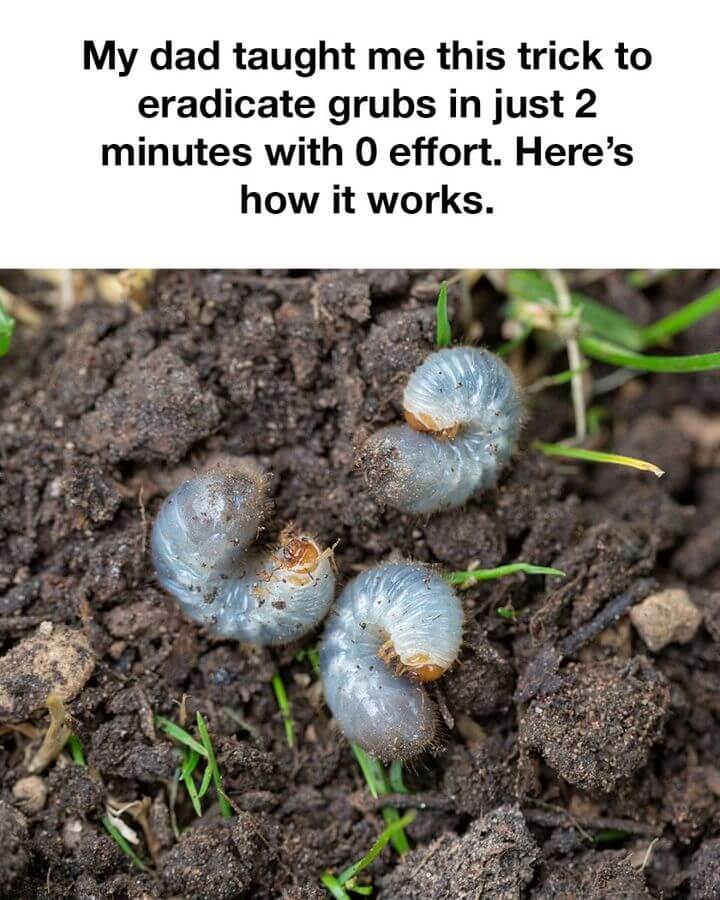Grubs are a persistent nuisance for gardeners and lawn lovers. These tiny white larvae, which eventually become beetles, can ruin healthy turf by damaging grass roots and inviting critters like raccoons and skunks who dig up your yard looking for a snack.
Over the years, I’ve experimented with several solutions, but none have been as quick or simple as the one my dad passed down to me. This easy technique takes only a couple of minutes, requires no hard labor, and actually delivers results.
What Exactly Are Grubs and Why Are They a Problem?
Before jumping into the fix, it helps to understand what grubs are. These C-shaped larvae come from beetles such as June beetles, Japanese beetles, and European chafers. They live beneath the surface, feeding on the roots of your grass, which results in brown patches and thinning turf.
Grubs usually begin their lifecycle in late summer when adult beetles lay eggs in the soil. Those eggs hatch into grubs that start feeding on roots right away, then burrow deeper to survive the winter. In spring, they return to the surface, eat more, then eventually mature into beetles and start the cycle all over again.
The Simple, 2-Minute Fix My Dad Taught Me
Now for the good part—here’s the ultra-simple method my dad swears by. It involves a common household item you probably already own: dish soap.
How to Do It: Step-by-Step Instructions
🧰 What You’ll Need:
- A bucket or large watering can
- Dish soap (any kind works, but biodegradable options are best)
- Water
- Hose or watering nozzle (optional but helpful)
🧪 Mix the Solution:
- Fill your bucket or watering can with around one gallon of water.
- Add 2 to 4 tablespoons of dish soap. The exact measurement doesn’t have to be perfect—just enough to make a soapy mix.
🌱 Apply to Trouble Spots:
- Look for signs of grub activity—wilting, yellowing, or thinning patches of grass.
- Pour your soapy water over these areas. For larger lawns, a hose-end sprayer can help distribute the mixture evenly.
⏳ Wait a Few Minutes:
- After you’ve applied the mixture, wait patiently. The grubs will begin surfacing as the soap irritates them.
🐦 Clean-Up:
- Once the grubs are visible on the surface, you can pick them up and throw them away. Or, if you leave them out, birds might handle the cleanup for you.
Why This Works: The Science Behind the Method
Dish soap lowers water’s surface tension, helping it reach deeper into the soil. When the soapy water touches grubs, it causes discomfort and even affects their breathing through tiny openings in their bodies. This forces them to surface, making it easier to remove them manually.
While this approach doesn’t immediately kill the grubs, it flushes them out of hiding. You might need to repeat the process or use it in combination with other natural remedies like nematodes or milky spore to eliminate them long-term.
Why This Method Stands Out
- Environmentally Friendly: It’s a safer choice compared to chemical pesticides—no harm to pets, people, or beneficial insects when used properly.
- Budget-Conscious: Most households already have dish soap, so there’s no need to buy expensive products.
- Fast and Simple: From start to finish, it only takes a couple of minutes.
- Instant Results: Watching grubs emerge within minutes gives you immediate feedback that it’s working.
Extra Tips to Keep Grubs Away for Good
While this method is great for handling a current problem, here’s how you can prevent future infestations:
- Lawn Care Basics: Mow your lawn properly, water it deeply but not too often, and aerate it regularly to promote healthy roots.
- Use Beneficial Nematodes: These tiny natural predators seek out grubs in the soil and destroy them without hurting your grass.
- Apply Milky Spore: A natural bacterium that specifically targets Japanese beetle grubs. Once established, it can provide lasting protection.
Grubs might seem like an overwhelming issue, but the trick my dad taught me proves that sometimes the simplest solutions are the best. The next time you see signs of grub damage, grab your dish soap, mix it with water, and treat your lawn. With consistent use and a few proactive steps, you can maintain a healthy, grub-free yard all season long.
